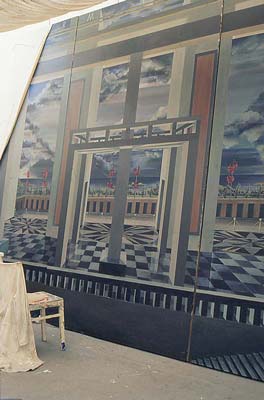Forenoon
In an open architectural space there are 24 figures (8 figures per area of the room). Each of them is a participant
in a game without winners or losers, is equal to the others, and equally replaceable. What appears each time to
be a newly crafted accident in the system, determines the cohesiveness of the individual positions. The system
of details functions in this context not through concrete determinations of recognizable, symbolic objects (i.e.
lemon signifies irritated eyes), but rather through the general emptiness of the framework in which they appear.
The framework limits what may be said to the possible relationships of recognizable things. For example: If the
proverbial head in the sand is called narrowness, then the related rope around ones neck could be called synchronous entry and exit - which in turn could have consequences for the pigeon on the bottle rack. Because the
individual is dissolved in the resistance-free flux of meanings, every possible (hi)story can describe reality, or not
- without contradicting the logic of the narrative process.
The compulsive relativism of superficially encased things has as its measure the collected information in a
momentarily changing level of knowledge possessed by a possible observer, the impossible outsider. The context
out of which a reference can remove itself does not result in a substantial unity or mass, but instead constitutes
the maximum dissolution of the inevitable. The construction of the real in a congruent picture no longer requires
legitimating, which could or must unveil the illusion of the fixed moment. The superfluous architect would say:
Where all keys are accounted for, so also the locks.
 The chronicle of the architect insists on his anti-utopian attitude: Painting as a medium, which allows for the closest
look at historical entanglements, leading up to the current possibilities and limitations of the picture, should be seen
as a means, not as an end. Self-reference as such, seen in classical and late modernism as the highest expression
of a conscious and integral form of communication, has lost its hold. It is today not only possible, but also necessary, to lead painting away from its compulsive narcism, even if its demand to be Art may thereby be forgotten.
The chronicle of the architect insists on his anti-utopian attitude: Painting as a medium, which allows for the closest
look at historical entanglements, leading up to the current possibilities and limitations of the picture, should be seen
as a means, not as an end. Self-reference as such, seen in classical and late modernism as the highest expression
of a conscious and integral form of communication, has lost its hold. It is today not only possible, but also necessary, to lead painting away from its compulsive narcism, even if its demand to be Art may thereby be forgotten.
Texts Without Verbs, Cologne 2002, p. 153